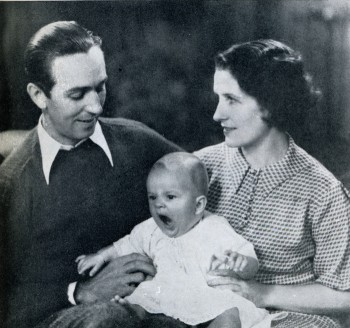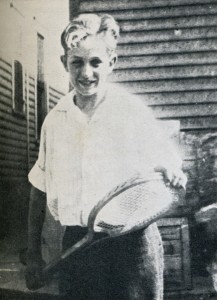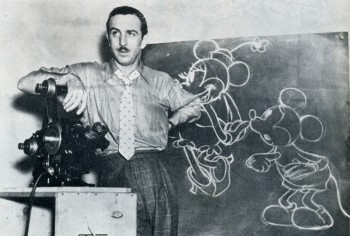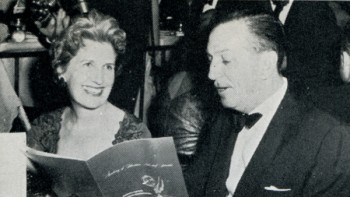Books &Commentary 03 Nov 2011 06:58 am
Dad’s Daughter’s book – an Overdue Review
 - I haven’t read the book, The Story of Walt Disney by Diane Disney Miller “as told to Pete Martin“, since it was originally published in 1957. Actually, I probably read the version that was serialized in the Saturday Evening Post in November 1956; then I most likely asked for a copy of the book for a Christmas present and read it then. After all, I was only 11.
- I haven’t read the book, The Story of Walt Disney by Diane Disney Miller “as told to Pete Martin“, since it was originally published in 1957. Actually, I probably read the version that was serialized in the Saturday Evening Post in November 1956; then I most likely asked for a copy of the book for a Christmas present and read it then. After all, I was only 11.
I remember being grabbed by the book and hooked for all time on animation. Two years later, the Bob Thomas Art of Animation would lock it up for me.
The Story of Walt Disney is an odd book to review. I wonder how much actual research went into the writing. Was it enough to have the source, Walt Disney, reveal his story verbally to Diane and Pete Miller? The voice undoubtedly comes through. The book comes off as one for youngsters; there’s an innocence in the writing that Pete Miller obviously got across. He did the writing; the book is labelled “by Diane Disney Miller as told to Pete Martin.” Martin was a writer for The Saturday Evening Post, where the book was serialized prior to its publication. Miller was also known for having collaborated with Bing Crosby on a book of memoirs before working on this Disney book.
 Since this book is essentially out of the mouth of Walt, we have to pay attention to some of the stories being told. What was told and what was skipped?
Since this book is essentially out of the mouth of Walt, we have to pay attention to some of the stories being told. What was told and what was skipped?
There’s quite a bit more than usual about the Red Cross service Disney did at the end of WWI.
The “Alice” series is called by the title “Alice in Cartoonland.” Unfortunately, the Disney brothers called the series the “Alice Comedies.” Even though their first short was known as “Alice’s Wonderland,” they didn’t refer to the others with any reference to Lewis Carroll’s work. That may well have been the demand of the distributor Charles Mintz even though the Disneys may have thought of the series as “Alice in Cartoonland.” Obviously, Walt referred to it as that title in telling this story.
There’s a mention of Ub Iwerks when Walt asked him to move out to LA, but there’s no mention of his name when Iwerks left Disney to open his own studio under the assistance of Pat Powers. There’s some detail in the chapter about Snow White, but barely a mention of Pinocchio or Bambi. Lots to tell about Fantasia and a bit more about Dumbo. No mention
 of Song of the South, Fun and Fancy Free or So Dear to My Heart, but Cinderella gets attention as do the documentary nature films. There’s an odd telling of the Disney strike in this book, and the suggestion of how the South American trip came about. In truth, the book becomes more about the juggling of money once Snow White goes into production and less about the actual films. There’s plenty of detail about going public with the stock options, and there’s a lot of detail about the government work done during WWII.
of Song of the South, Fun and Fancy Free or So Dear to My Heart, but Cinderella gets attention as do the documentary nature films. There’s an odd telling of the Disney strike in this book, and the suggestion of how the South American trip came about. In truth, the book becomes more about the juggling of money once Snow White goes into production and less about the actual films. There’s plenty of detail about going public with the stock options, and there’s a lot of detail about the government work done during WWII.
An interesting sentence comes at the beginning of the book when we read about the farm in Marcelline in hs childhood. “He can still draw a mental – or rather a sentimental – map of that whole community exactly as it was then.” This is a rare sentence by Diane commenting on her father’s recollections, and one wishes there were more like it. The last chapter of the book offers a bit more of this when Diane decides to tell a bit more about her father away from the office. What he likes to eat, how he acts, etc. There’s a lot of personality in this chapter.
One wonders how useful this book is for actual animation historians. Mike Barrier and John Canemaker have obviously read it, but do they trust the material? And why shouldn’t they, especially if there’s a second source for any of it. The story as a whole is very readable, and one rolls along easily in the telling of the tale. It’s especially entertaining. Obviously, the goal was to make the story for the largest possible audience, so details of the films were less interesting than the struggles of the imaginative entrepreneur.
 You know that “dad” enjoyed telling his daughter of all his accomplishments. So this is his version, and it’s interesting how it comes out filtered through the voices of Diane and Pete Miller. Diane’s pride in the studio is certainly as great as Walt’s.
You know that “dad” enjoyed telling his daughter of all his accomplishments. So this is his version, and it’s interesting how it comes out filtered through the voices of Diane and Pete Miller. Diane’s pride in the studio is certainly as great as Walt’s.
- “Father did the outlines of the drawings. The other two filled them in. Gradually Father gave them bigger assignments, until they were doing whole scenes themselves. Even then Father insisted upon a distinctive Disney style of drawing and photography, and he trained his two helpers to do things his way.
.
“They weren’t the only ones who have conformed to the Disney style. Almost all animated techniques since have conformed to the basic formulas that emerged from that primitive studio. Although they may vary in spirit, or another cartoon maker’s conception of what gives greater pictorial impact may differ from Father’s, they all owe a debt that goes back to the inventiveness and experimentation that went on in the back room of that converted real estate office.”
That sense of pride is understandable.
The Story of Walt Disney is actually a good read if you have a copy and haven’t seen it in years. Or you might be able to locate a copy in the library. Take the time; it moves quickly and is fun.

on 03 Nov 2011 at 4:06 pm 1.Mark Sonntag said …
Another book to look at is WALT DISNEY’S MISSOURI for stories on his early years.
on 04 Nov 2011 at 1:53 am 2.David McBride said …
I don’t know if you’ve read this book or not but I really enjoyed “How to be like Walt” by Pat Williams with Jim Denney. It feels like he went the extra mile with his research and I found it to be very captivating.
This book sounds very interesting thanks for posting.
on 04 Nov 2011 at 12:24 pm 3.Tom Minton said …
In the early 1990s I was at Disney and requested, as any employee then could, to listen to several hours of archival 1950s audio interviews that Walt had done with authors and journalists for various print projects. What was jarring to hear was the frequency and obvious chronic nature of Walt’s heavy ‘smoker’s cough’, which interrupted several of his sentences, particularly whenever he became emotionally agitated about anything. Such coughing episodes were edited out of any filmed television hosting Walt did and any photos (other than the one with him reclining on that sofa in the Fantasia book) of him with a smoldering cigarette were cropped to edit the smokes. It has been said that the animators could hear Walt coming due to his cough preceding his appearance. Some believe that Walt sometimes coughed deliberately to signal his impending arrival. Hearing those tapes, I wonder if he could control the reflex at all.